The LG G8 Review: Solid, But Not Great
by Andrei Frumusanu on April 30, 2019 1:00 PM EST- Posted in
- Mobile
- LG
- Smartphones
- LG G8
- LG G8 ThinQ
Display Measurement
As mentioned before, the G8 is a special device for LG as it represents the very first G-series phone which comes with an OLED screen. This is quite intriguing but also worrisome as the company hasn’t had a great track-record with OLED displays, suffering either from display quality issues or from power consumption issues.
For the new G8 to be considered a worthwhile consideration, it needs to get the display right. Thankfully, when it comes to the quality of the display panel (Uniformity), the phone doesn’t showcase any issues, which leaves display calibration as well as power consumption the remaining deciding factors.
As always, we thank X-Rite and SpecraCal, as our measurements are performed with an X-Rite i1Pro 2 spectrophotometer, with the exception of black levels which are measured with an i1Display Pro colorimeter. Data is collected and examined using SpectraCal's CalMAN software.
Compared to the G7’s LCD screen, one expected degradation from the move to an OLED screen is lower brightness levels, as the G7’s RGBW display showcased some class-leading display brightness reaching up to 1000 nits at 100% APL white.

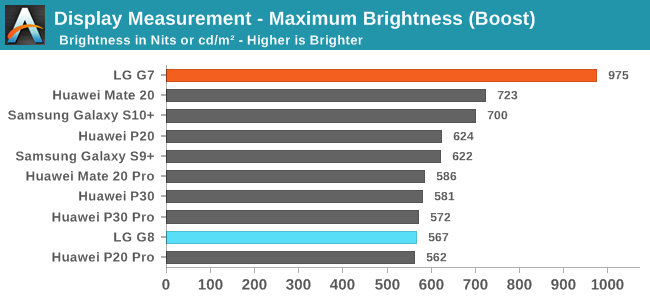
In manual maximum brightness, the G8 goes up to 388 nits when displaying full white, while when in bright conditions under the automatic mode the display boosts up to 567 nits. While per se the figures aren’t bad, the G8 does lag behind the newer Samsung S10 and also especially lags behind the G7’s incredibly high brightness levels.
In bright daylight situations I found the G8 to be acceptable, but not outstanding. It’s to be noted that LG scales brightness very aggressively with varying APL (average picture level), but even in lower APL levels the phone just isn’t as bright as competing devices.
In terms of display calibrations, LG offers a grand total of 7 different display modes, including “Auto”, “Cinema”, “Sports”, “Game”, “Photos”, “Web” and a more customisable “Expert”.
Among all of these, “Web” is the only sRGB gamut target display mode, while the “Cinema” mode seemingly targets a more accurate Display P3 profile. We’re limiting our evaluation to these two modes as they represent the most accurate modes on the G8.
Colour balance on the G8 unfortunately is a major issue, and although the “Web” profile showcases the best white-balance, it’s still veering off towards blues with a higher 6847K average CCT. The colour balance isn’t an issue of the profile but seemingly an issue of the calibration, as the display is able to showcase near perfect whites when at maximum brightness, with an ever increasing deviation the lower the brightness goes.
Gamma is also a major issue for the G8. At 200 nits, the phone is massively off-target with a 2.7 average gamma, with mid-levels exceeding 2.8, meaning tones appear darker than they should be. Again this issue is highly dependent on brightness as it’s not nearly as pronounced at maximum brightness.

The end greyscale accuracy score for the G8 ends up at a measly DeltaE2000 of 4.85. While this is an improvement over the G7’s atrocious calibration, it’s still quite bad. This time around it’s not the colour balance that is the worst offender, but rather the massively off-mark gamma.
As mentioned, the “Web” profile is the only mode which offers a target gamut seemingly aiming for sRGB. However things are still quite off the mark here as it overshoots the gamut in the greens, and ever so slightly in the reds. What is again the key offender here isn’t this slightly larger-than-sRGB gamut, but rather the fact that the saturations are non-linear, showing some clear saturation compression which tends to oversaturate all levels.
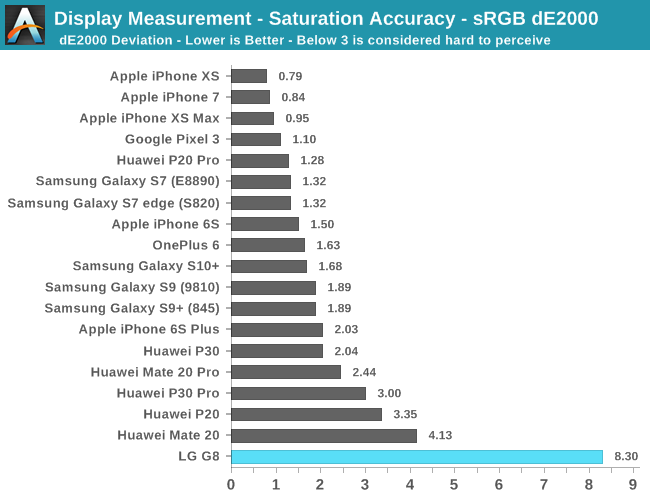
The resulting deltaE2000 is one of the worst we’ve ever measured, reaching 8.3 which is borderline unacceptable.
The “Cinema” mode offers the most accurate Display P3 gamut profile, and here again we’re seeing the same issues as on the “Web” profile. LG again overshoots the gamut in the greens, although this time doesn’t reach the target red levels. We see the same saturation compression issue with non-linear levels which means lower tone levels are just much too oversaturated.
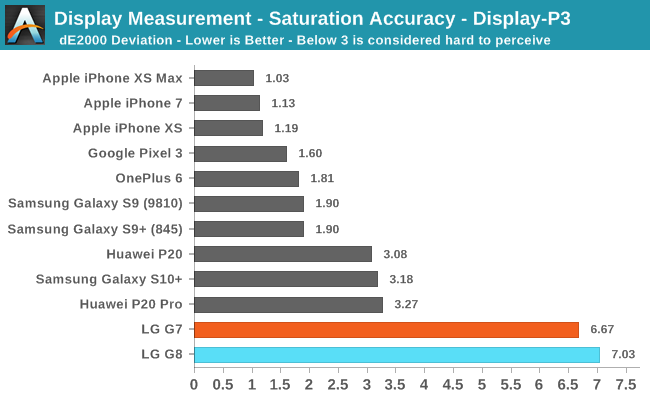
Here we have a comparison to the G7 (The phone didn’t have an sRGB mode), and shockingly it fares even slightly worse in terms of colour accuracy than last year’s disastrous result, with a dE2000 of 7.03.

Finally, in our Gretag-Macbeth test of commonly found tones such as skin tones, the G8 is just an outright disaster. I would like to point out to the detailed dE2000 results of the individual tones which exceed 10 and some even reach values of up to 15.
While most tones aren’t too terrible in terms of their target hue, their saturation and luminosity (gamma) are completely off the mark.
The end result is a shameful dE2000 of 8.92, which I think is the worst display calibration we’ve ever measured on a phone. It’s to be noted that the measurements here are done in the “Web” profile, LG’s other profiles are even worse than this.
Overall Display Verdict
While the G8’s display has no issues in terms of uniformity and showcases great viewing angles, and its brightness levels is somewhat acceptable, the phone simply doesn’t have any accurate display mode.
I find it very odd that LG had introduced the new supposedly accurate “Web” profile in the V40 and G8, yet the company only did a half-hearted job in terms of actually making this an accurate display mode. The result is that the G8’s colours are consistently off-mark, with some of the worst calibration results we’ve ever seen in a smartphone.


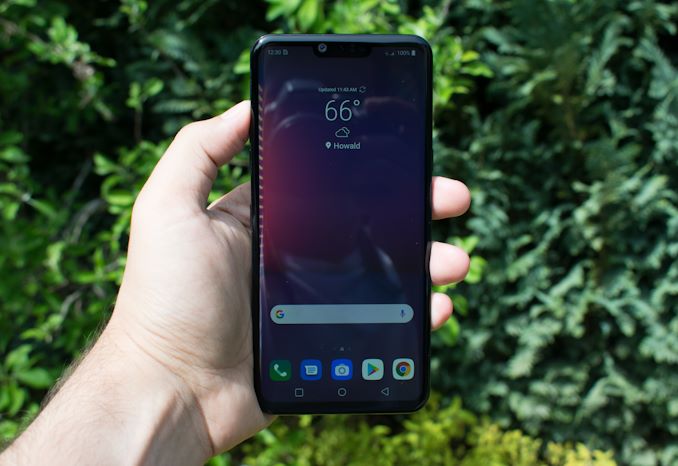
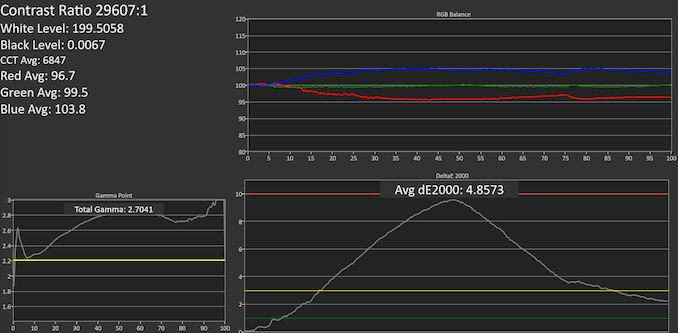

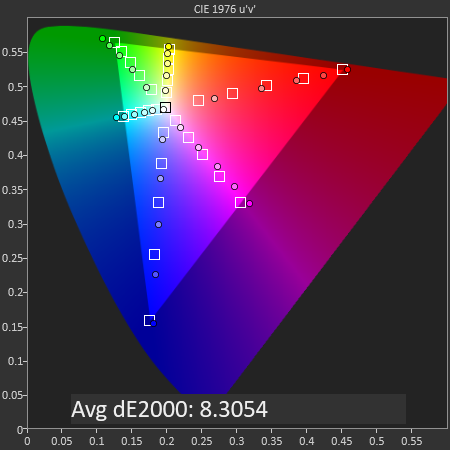

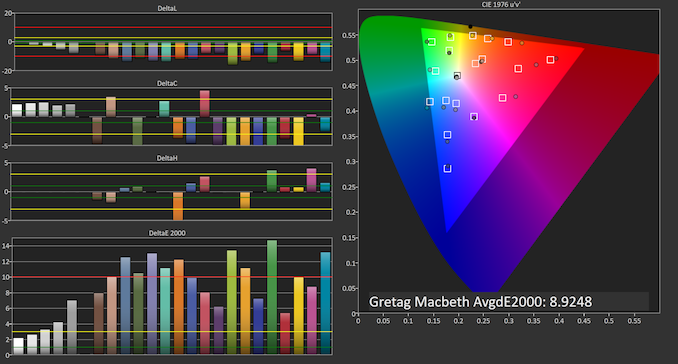









70 Comments
View All Comments
abufrejoval - Thursday, May 2, 2019 - link
That is a very nice looking Ford Granada GLX!I sure did not expect one of those still in the wild, especially since the spare parts deposit burned down in 1977.
Great review!
LG earns a lot of respect that they keep on sending units to AT.
klingon55 - Thursday, May 2, 2019 - link
The LG G6 had an OLED display. So this is not the first.Andrei Frumusanu - Friday, May 3, 2019 - link
The G6 was an LCD...808Hilo - Thursday, May 2, 2019 - link
Looks like a highly defective copy of my Essential ph-1. Which, after, 2 years, is still state of the art. I wonder why those large corps cannot make a single decent unflawed phone for a change.Wardrive86 - Saturday, May 4, 2019 - link
Looks like LG is using the same heat dissipation pipe on the G7 and G8. Average 18% more GPU peak performance, average 18% more GPU sustained performance in essentially the same body. Impressive IMOdr_pingu - Sunday, May 5, 2019 - link
Had a g4 with the classic bootloop. Company never admited the bad manufacturing (officially in Spain). OFC never buying nor recomending brands like that, they can crash asap imovortmax2 - Tuesday, May 7, 2019 - link
"Here the G8 is not only noticeable slower as the new Galaxy S10 in both SoC variants, but it’s also noticeably slower than many of last year’s Snapdragon 855 devices."Think you meant '845 devices'.
KristenBrown - Wednesday, May 8, 2019 - link
Awesome review!Mark Dirac - Monday, May 13, 2019 - link
Why on earth do LG not simply permit disabling of the camera's over sharpening? My LG G6's images were so dreadful that I didn't bother taking any photos with it for 6 months, until Open Camera introduced the capability to switch off the LG G6's sharpening and noise reduction (Camera2 API). At which point I found I had a pretty good camera.yindesu - Sunday, September 11, 2022 - link
> What is most shocking however is the fact that the G8 feels slower than the G7. In side-by-side comparisons between the two phones, the G8 is slower in opening a lot of applications or in-app views. This is extremely disappointing and clearly points out that LG has messed up somewhere in terms of the SoC’s BSP integration.Is it not explained by the G8 using eMMC storage when the G7 had UFS 2.1?